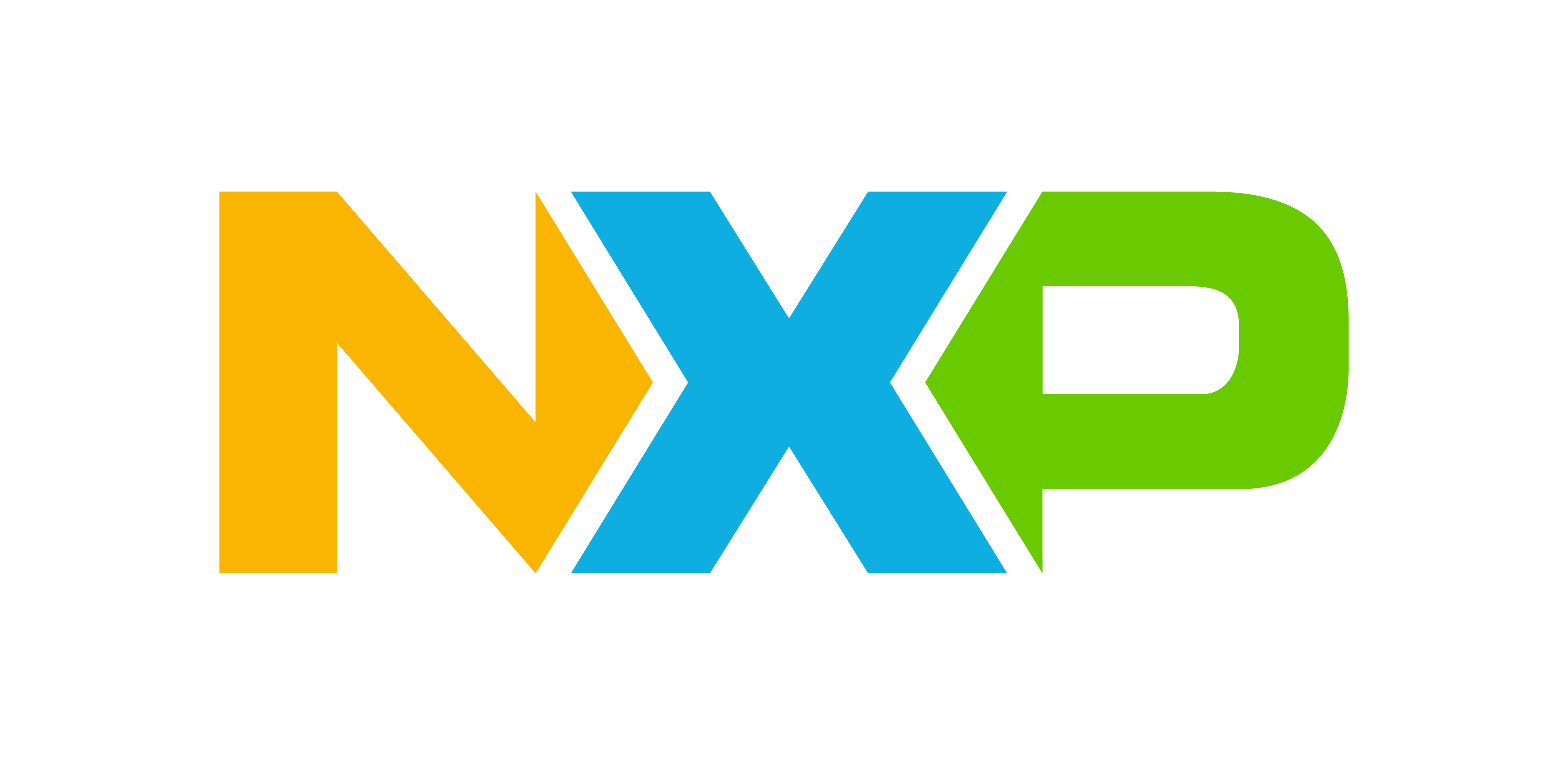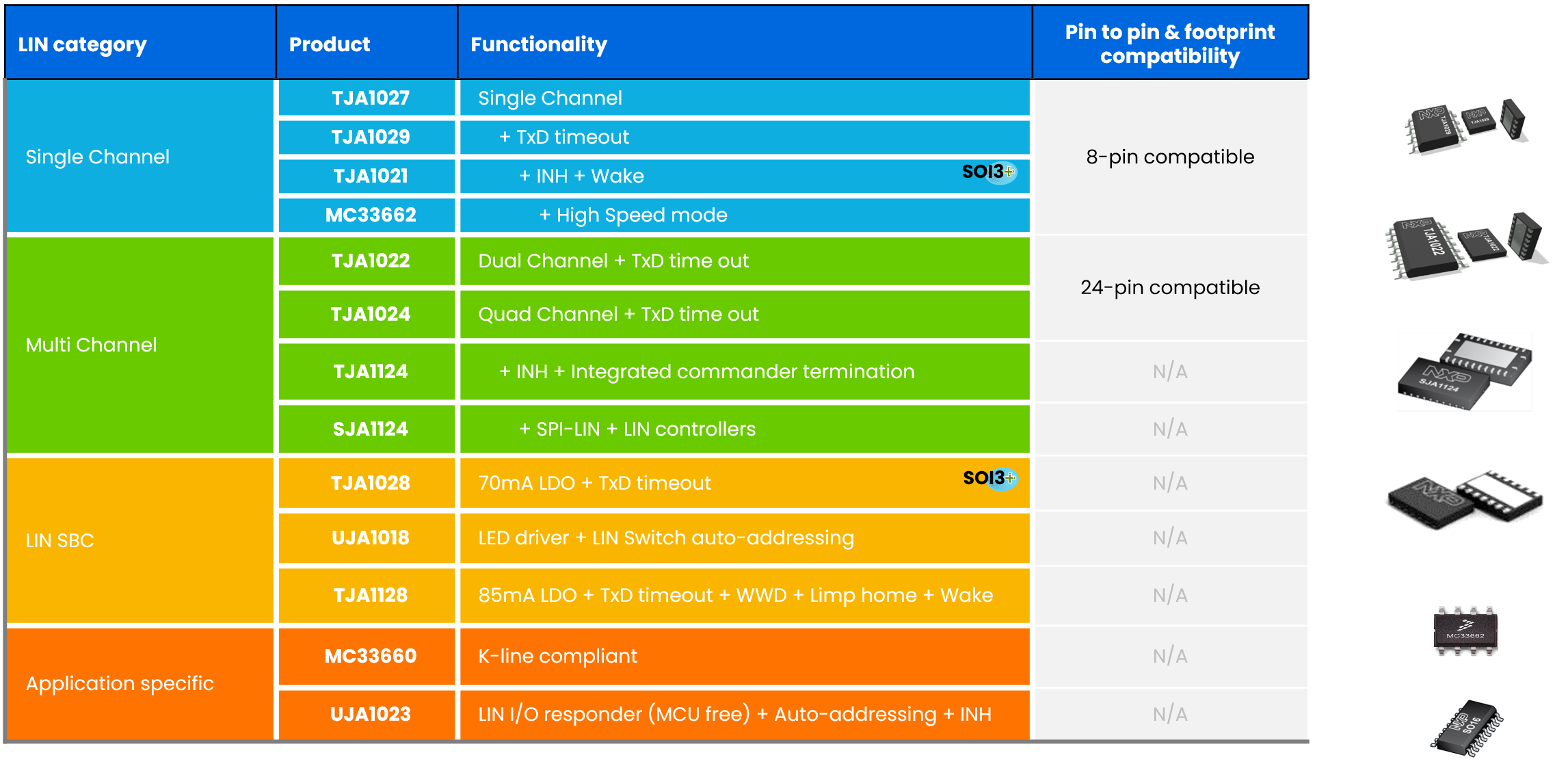
- NXP Semiconductors N.V.
- NEXT Mobility
- ICT and Industrial
The increasing electrification and complexity of automotive systems place significant demands on in-vehicle networks, which are crucial for communication between Electronic Control Units (ECUs). These networks require high signal quality, seamless interconnectivity, low power consumption, and excellent EMC performance.
NXP is a widely recognized leader in automotive networking technology, offering an extensive product range, particularly in physical layer (PHY) transceivers for CAN (Controller Area Network) and LIN (Local Interconnect Network).
This page provides an overview of the features of NXP's automotive CAN/LIN transceiver products, designed to withstand the demanding conditions of the automotive environment. This information is specifically aimed at ECU development manufacturers seeking reliable in-vehicle network solutions.
Development and Manufacturing System Supporting NXP's Automotive Network Products
At NXP, CAN/LIN transceivers are categorized as automotive network products.
This section introduces the robust development and manufacturing system that underpins NXP's offerings in this area.
NXP's automotive network products are developed and manufactured based on five core principles: Quality, Supply, Support, Product Portfolio, and Innovation.

Five Pillars Characterizing NXP's Automotive Network Products
- Quality:A continuous commitment to reducing defect rates, driven by a zero-defect philosophy.
- Supply:Implementation of multi-sourcing, with production taking place across multiple factories. This strategy supports customer business continuity planning.
- Support:A global network of technical support centers ensures prompt and flexible assistance.
- Product Portfolio:A comprehensive range of products is available to meet diverse customer needs.
- Innovation:Rapid adoption of new technologies and standards enables the timely introduction of products that address evolving market demands.
Quality of Automotive Network Products
NXP demonstrates a comprehensive commitment to quality by consistently striving for zero defects. This dedication allows for the timely introduction of innovative products that meet stringent quality requirements and are backed by excellent customer support.
Ultimately, the aim is to surpass customer expectations.
This overall quality is achieved through a deeply ingrained quality-first mindset and culture, a fundamental aspect of NXP's operations.
Benefits of Product Multi-Sourcing
NXP's automotive network products benefit from a multi-sourcing strategymeaning they are produced in multiple manufacturing facilities.
This approach offers several key advantages:
- Enables flexible supply capabilities.
- Establishes a highly reliable production infrastructure.
- Contributes to reduced lead times.
- Strengthens the assurance of consistent supply.
- Simplifies supply management in the event of disruptions such as natural disasters.
By advancing multi-sourcing, we enable a broader combination of factories for both front-end and back-end processes. This helps establish a more diverse production system, which enhances supply stability and ensures business continuity.
NXP's Automotive CAN Transceivers
CAN (Controller Area Network) is a standard communication protocol used for high-speed serial data communication between multiple ECUs (Electronic Control Units) within a vehicle.
CAN Product Innovation Initiatives
NXP plays a vital role in the advancement of automotive network technology and is an active participant in the standardization efforts for CAN protocols. NXP has been involved in the development of the ISO 11898 standard, which defines the CAN protocol, and continues to contribute to the creation of new technical specifications such as CAN FD and CAN XL.
As part of NXP's commitment to innovation within its CAN product line, we will highlight the following three key areas:
- Support for the latest CAN communication protocols
- Solutions for Bridging Different Voltage Domains
- Integration of Security Features

NXP's Innovation in CAN Products
Support for the latest CAN communication protocols
NXP's CAN Physical Layer (PHY) products are designed to be compatible with the most current communication protocols.
Let's explore the various types of CAN protocols:
- CAN (Controller Area Network)
CAN is a widely established and standard communication protocol used extensively in in-vehicle networks. It is implemented in systems where real-time communication and high reliability are critical, such as those controlling the engine, transmission, steering, and braking systems within a vehicle.
- CAN FD (Flexible Data-rate)
CAN FD offers significant improvements over traditional CAN by enabling faster data communication speeds and the transfer of larger data payloads. This enhanced capability makes it well-suited for applications like in-vehicle infotainment systems and Advanced Driver Assistance Systems (ADAS).
- CAN XL (Extra Long) - Products Under Development
CAN XL is being developed as the next generation of in-vehicle network protocols. It promises even faster data communication and the ability to transfer larger amounts of data compared to CAN FD. This advancement will be crucial for supporting future high-performance automotive systems, including autonomous vehicles, sophisticated ADAS functionalities, and the comprehensive integration of the entire in-vehicle network.
- Comparison of CAN Protocols
| Protocol | Data rate | Up to 1 Mbps | CAN XL |
|---|---|---|---|
| Data rate | Up to 1 Mbps | 1~8 Mbps | 10~ Mbps |
| Frame size | Max data length 8 bytes | Max data length 64 bytes | Max data length 2048 bytes |
| Error detection | Uses CRC | Enhanced CRC | Further enhanced CRC |
| Compatibility | ― | Backward compatible with conventional CAN | Backward compatible with conventional CAN FD |
CRC: Cyclic Redundancy Check
Solutions for Bridging Different Voltage Domains
NXP's CAN Physical Layer (PHY) product line features isolated CAN transceivers designed to bridge different voltage domains.
In electric vehicles (EVs) and hybrid cars, networks operating at both high and low voltage levels coexist. NXP's isolated CAN transceivers facilitate secure communication in these environments by providing electrical isolation between systems with differing ground potentials through galvanic isolation. Integrating an isolator directly into the CAN transceiver significantly simplifies the design of safety bridges that connect these high and low voltage levels.
NXP's isolated CAN transceivers incorporate protection mechanisms against electric shock, overvoltage conditions, offset currents, and reverse current flow. Furthermore, they substantially enhance signal integrity in environments with high levels of electrical noise.
Integration of Security Features
NXP's CAN PHY product line also offers secure CAN transceivers, which integrate security functionalities into CAN communication.
These secure CAN transceivers from NXP provide a streamlined and cost-effective method to secure traditional CAN and CAN FD communication without the complexities of encryption. The secure CAN transceiver incorporates built-in filters that enable hardware-based authentication of local CAN communication. They also feature transmission bandwidth limiting capabilities. This prevents flooding attacks (Denial of Service) originating from the local host, without introducing bandwidth overhead, latency, or placing a burden on the processor with authentication and encryption software. The transceivers can detect security incidents such as "tampering," where a local host attempts to transmit a CAN message with an unassigned identifier, and "spoofing," where a CAN message containing an identifier exclusively assigned to the local host is received. Upon detection of such incidents, the transceiver transmits an active error frame, effectively invalidating the compromised message.
Types of Automotive CAN Transceivers
This section explains the types of NXP's CAN transceivers based on their power-saving modes.
Basic CAN
- This product line performs only basic CAN transmission and reception.
- They are the lowest-cost and most compact option (8-pin
- VIO (power terminal for adjusting TXD, RXD threshold voltage when MCU voltage is not 5V) is optional.
- TJA1057 High-Speed CAN Transceiver - Mantis Family

TJA1057 Block Diagram
Standby Mode CAN
- Standby mode reduces power consumption.
- The standby mode is controlled via the STB pin
- Used when CAN wake-up function is needed.
- Package is 8-pin, same as the basic model.
- VIO (power terminal for adjusting TXD, RXD threshold voltage when MCU voltage is not 5V) is optional.
- TJA1044 High-Speed CAN Transceiver with Standby Mode

TJA1044 Block Diagram
Sleep Mode CAN
- Sleep mode enables the development of more advanced low-power systems. In addition to reducing CAN IC power consumption, it allows ECU power ON/OFF control via the INH pin.
- To provide additional system control and battery power input pins, the package is expanded to 14 pins.
- TJA1043 High Speed CAN transceiver

TJA1043 Block Diagram
Recommended CAN Transceiver Products
This section highlights recommended CAN transceiver products within NXP's comprehensive automotive network portfolio.
In the table provided, the "CAN SIC" column on the far right indicates products that incorporate SIC functionality into CAN transceivers already equipped with Standby and Sleep Modes. SIC (Signal Improvement Capability) is a feature designed to mitigate signal ringing on the CAN bus, thereby enhancing overall signal quality. Notably, CAN SIC transceivers can be implemented as direct replacements for standard CAN transceivers.

Recommended CAN Transceivers from NXP
For more details, please visit the NXP official site: CAN Transceivers
NXP's Automotive LIN Transceivers
Automotive LIN (Local Interconnect Network) is a network protocol specifically developed to facilitate low-speed serial data communication between Electronic Control Units (ECUs) within a vehicle. LIN is mainly used in applications requiring cost efficiency, providing slower and simpler communication than CAN (Controller Area Network).
LIN Product Lineup
NXP's LIN product range encompasses basic Single Channel LIN transceivers as its foundation, extending to Multi-Channel LIN transceivers that support multiple channels (such as Dual and Quad configurations), and LIN SBCs (System Basis Chips) which integrate additional power management functionalities.

NXP Automotive Network LIN Product Lineup
- For applications requiring only a LIN transceiver, the Single Channel LIN transceiver is the recommended choice.
- If both LIN connectivity and system miniaturization are important, consider LIN SBCs, which integrate power supply, reset, and watchdog functionalities.
- For systems utilizing multiple LIN channels, Multi-Channel LIN transceivers, which integrate several LIN transceivers into a single package, are the suggested solution.
Single Channel LIN Transceiver
Let's take a look at the most fundamental offering within NXP's LIN transceiver products: the Single Channel LIN transceiver.
| TJA1027 | Among Single Channel LIN transceivers, Core LIN transceivers provide only basic functionalities |
|---|---|
| TJA1029 | A basic LIN transceiver that adds a dominant timeout function to the TJA1027 |
| TJA1021 | A standard LIN transceiver that adds an INH pin for controlling an external power regulator and a wake-up function from a local microcontroller to the TJA1029 |
| MC33662(B) | A standard LIN transceiver that adds high-speed LIN communication functionality to the TJA1021 |

Key Spec Comparison of NXP's Single Channel LIN Products
For more details, please visit the NXP official site: Automotive LIN Solutions.
Summary
This section provided an overview of NXP's automotive network product offerings, with a specific focus on CAN and LIN transceivers.
NXP's comprehensive portfolio of automotive network products is designed to address a diverse range of customer requirements. Should you have any interest in exploring these solutions further, please do not hesitate to contact NEXTY Electronics for more information.
Related Info
Part Information
View part information for the featured products on e-NEXTY, the parts information site operated by NEXTY Electronics.
Inquiry
Related Product Information

In-Depth Guide to NXP's Automotive PMICs (Page 2/2): Fundamentals and Key Features
This article explains the need for PMICs in automotive ECUs and introduces NXP’s automotive PMIC portfolio and key product features.
- NXP Semiconductors N.V.
- NEXT Mobility

In-Depth Guide to NXP's Automotive PMICs (Page 1/2): Fundamentals and Key Features
This article explains the importance of PMICs in automotive ECUs and introduces the features, advantages, and portfolio of NXP’s automotive PMICs. It covers the basics of PMICs and highlights NXP’s offerings.
- NXP Semiconductors N.V.
- NEXT Mobility

An In-Depth Look at the Advantages of NXP's Automotive Microcontroller S32K1
NXP’s S32K1 automotive microcontroller series features ARM Cortex-M0+ and M4F cores, delivering high performance with low power consumption. This article provides a detailed overview of its benefits and features.
- NXP Semiconductors N.V.
- NEXT Mobility

Introduction to NXP's Automotive General-Purpose Microcontroller Products
NXP’s general-purpose automotive microcontrollers—S32K1, S12 MagniV, and S32K3 families—combine high performance, security, and cost efficiency to support the advancement of automotive technologies.
- NXP Semiconductors N.V.
- NEXT Mobility

NXP Automotive Microcontroller S32K311 Evaluation Board by NEXTY Electronics
The S32K311 is NXP's latest automotive microcontroller that offers high performance and advanced features at a low cost in a compact package. This article introduces its key features and our custom S32K evaluation board.
- NXP Semiconductors N.V.
- NEXT Mobility

Introduction to Edge AI Solutions with NXP's NPU-equipped i.MX/MCX
This article explains the rapidly growing edge AI with real device examples and introduces NXP’s processors and microcontrollers equipped with NPUs.
- NXP Semiconductors N.V.
- NEXT Mobility
- ICT and Industrial
- Smart Factories and Robotics
Link to Related Technical Columns

Building an i.MX development environment (Yocto edition) | Technical column
This article explains how to set up a Yocto development environment using NXP’s i.MX series. It covers hardware, preparation steps, and build procedures, helping you prepare to flash images on i.MX evaluation boards.

Building an i.MX Development Environment (uuu Edition) | Technical Column
This is the second installment of our series of articles on how to build an i.MX development environment. In this column, we will show you how to write the files generated by bitbake to an i.MX evaluation board and perform a simple function check.

How to start creating GUI using GUI Guider | Technical Column
As the use of GUIs grows, high development tool costs have become a challenge. NXP’s free tool, GUI Guider, supports a wide range of GUIs for evaluation boards.

